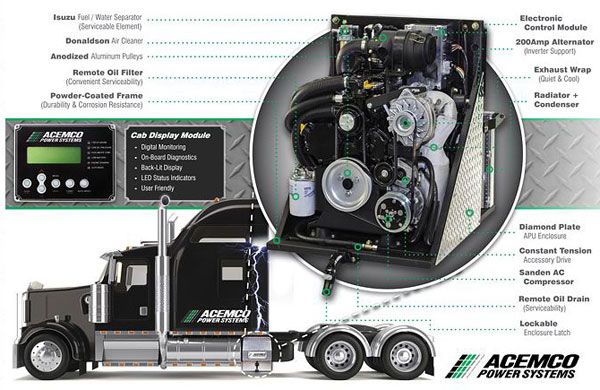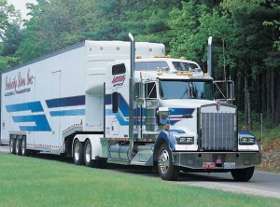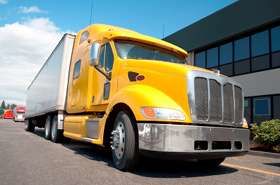Steer Tires
Topic 12619 | Page 2

Didn't see that part of the statement, I would then ask the shop to either move it for me or put 13000lb steers on my truck all though for the most part if I was over by that little amount I would usually just plan my fuel stops to be after I cross the coop or I would dodge them all together.
Your weight is fine man. You're allowed more than 12,000 depending on your tires specifications. Personally, I like my steers heavier for just a tad bit more traction in the winter with them - I run them at 12,450 and no one has ever said anything about it. You're totally fine sir.

Also do you have an APU , the added weight could put you over on your Steers and/or your 80,000,,, there is a weight break exception for the Added weight,, but I believe it depends on State by State :(
APU:
Auxiliary Power Unit
On tractor trailers, and APU is a small diesel engine that powers a heat and air conditioning unit while charging the truck's main batteries at the same time. This allows the driver to remain comfortable in the cab and have access to electric power without running the main truck engine.
Having an APU helps save money in fuel costs and saves wear and tear on the main engine, though they tend to be expensive to install and maintain. Therefore only a very small percentage of the trucks on the road today come equipped with an APU.


Thanks everyone.
I head in on Tuesday and will talk to the shop about it then.
I have been green lighted through weight stations so far so figured they must allow a tolerance.
Physics obviously wasn't my strong suit since I figured the more weight i put on my drive tires would mean less on my steer and trailer tires.
Nate, for starters your 5th wheel is in the perfect spot and you don't have to touch a thing. As was mentioned already, steer tires have a slight tolerance when it comes to their weight rating and most states allow over 12,000 on the steers nowadays. Being at 12,100 on your steers is pretty much perfect for a heavy load. You'd like to avoid that extra 100 pounds if you're in a state that caps the limit at 12,000 and to do that you have to control what?
Anyone know?
That's right - fuel. The majority of the weight of fuel will fall on your steer tires. So if you're loaded really heavy you may try scaling it with just a little less fuel in it and see what you get. But don't sweat that 100 pounds too much. That shouldn't be an issue.
Nate, and everyone getting started in trucking, go through our Truck Weight And Balance section of our High Road Training Program. It covers all kinds of topics including:
1) How to properly load cargo
2) How to balance the weight amongst the axle sets
3) Calculate how much to slide your tandems or 5th wheel
4) Determine what percentage of fuel weight is distributed to your steer and drive axles
5) Calculate how much fuel you can take on based on your current axle weights
........and a bunch more.
It's seriously disturbing how little people know when they're released to run solo. Schools and companies don't cover a lot of the basics which is why we've built them into our High Road.
While I'm at it, Learning The Logbook Rules is another area no one covers enough so we built a huge section on that also.
CDL:
Commercial Driver's License (CDL)
A CDL is required to drive any of the following vehicles:
- Any combination of vehicles with a gross combined weight rating (GCWR) of 26,001 or more pounds, providing the gross vehicle weight rating (GVWR) of the vehicle being towed is in excess of 10,000 pounds.
- Any single vehicle with a GVWR of 26,001 or more pounds, or any such vehicle towing another not in excess of 10,000 pounds.
- Any vehicle, regardless of size, designed to transport 16 or more persons, including the driver.
- Any vehicle required by federal regulations to be placarded while transporting hazardous materials.
Logbook:
A written or electronic record of a driver's duty status which must be maintained at all times. The driver records the amount of time spent driving, on-duty not driving, in the sleeper berth, or off duty. The enforcement of the Hours Of Service Rules (HOS) are based upon the entries put in a driver's logbook.
Tandems:
Tandem Axles
A set of axles spaced close together, legally defined as more than 40 and less than 96 inches apart by the USDOT. Drivers tend to refer to the tandem axles on their trailer as just "tandems". You might hear a driver say, "I'm 400 pounds overweight on my tandems", referring to his trailer tandems, not his tractor tandems. Tractor tandems are generally just referred to as "drives" which is short for "drive axles".
Tandem:
Tandem Axles
A set of axles spaced close together, legally defined as more than 40 and less than 96 inches apart by the USDOT. Drivers tend to refer to the tandem axles on their trailer as just "tandems". You might hear a driver say, "I'm 400 pounds overweight on my tandems", referring to his trailer tandems, not his tractor tandems. Tractor tandems are generally just referred to as "drives" which is short for "drive axles".

Since after reading every post, no one has mentioned it yet I'll say... your fuel weighs about 7 lbs per gallon. the exact weight is 7.5 lbs per gallon.
You can now use this added knowledge to figure out how much fuel you can hold to keep you at the proper weight. so if you put in just 14 gallons less of fuel that would put at the right weight when you are 100lbs over.
I don't have enough experience yet to make any comment on things like being slightly over and what not... just thought I'd let you know how much the fuel actually weighs since I saw it multiple times that you can adjust how much fuel you have in the tanks to adjust weight but nobody said how much it weighs per gallon.
Phox, that's way too simplified. You need to know what percentage of that weight goes to the steers. That number is different on each individual truck depending on several factors. The High Road Training Program will teach you how to calculate this.
CDL:
Commercial Driver's License (CDL)
A CDL is required to drive any of the following vehicles:
- Any combination of vehicles with a gross combined weight rating (GCWR) of 26,001 or more pounds, providing the gross vehicle weight rating (GVWR) of the vehicle being towed is in excess of 10,000 pounds.
- Any single vehicle with a GVWR of 26,001 or more pounds, or any such vehicle towing another not in excess of 10,000 pounds.
- Any vehicle, regardless of size, designed to transport 16 or more persons, including the driver.
- Any vehicle required by federal regulations to be placarded while transporting hazardous materials.

Got pulled into a weigh station today in Illinois and he waved me through so that 100 pounds must be ok. Since the majority of my runs are through Wisconsin, Illinois, and Indiana I think I am ok.

Got pulled into a weigh station today in Illinois and he waved me through so that 100 pounds must be ok. Since the majority of my runs are through Wisconsin, Illinois, and Indiana I think I am ok.
Mate do you have a truck atlas? All the steer ax el ratings per state are in there IL is 20k but I would not exseed the tire rating. Indiana is 12k. All this is found in page a16 in mine.
New Reply:
New! Check out our help videos for a better understanding of our forum features

















Preview:
This topic has the following tags:
Advice For New Truck Drivers Driver Responsibilities Truck Equipment







 TT On Facebook
TT On Facebook
He said his is the non adjustable 5th wheel